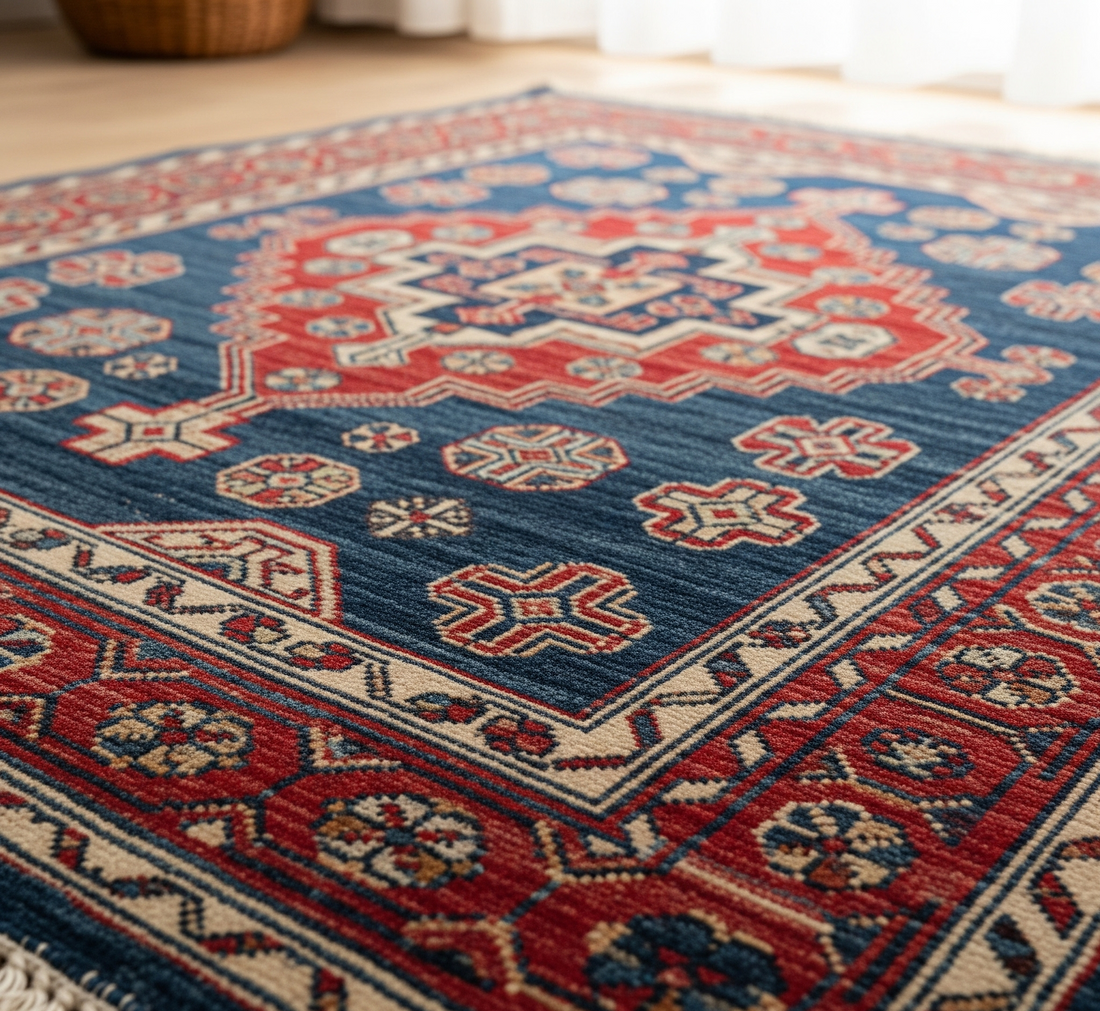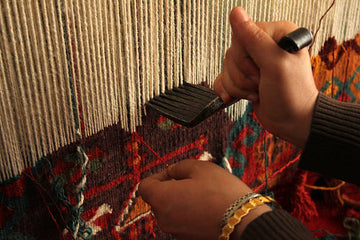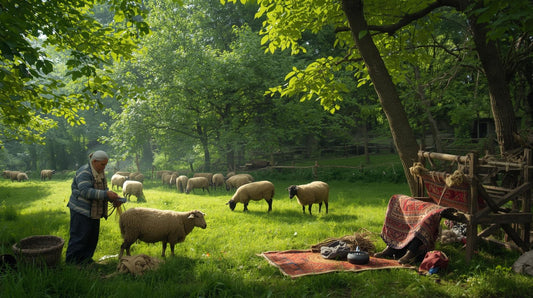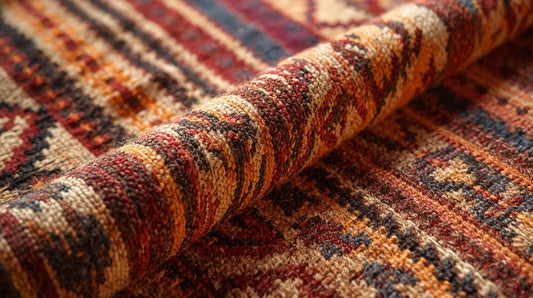The Sustainable and Natural Dimension of Hand-Woven Carpets: An In-Depth Analysis

Hand-woven textiles represent a rich legacy of craftsmanship, characterized by fabrics meticulously created on looms operated manually by skilled weavers. This intricate process involves the interlacing of warp and weft threads without the reliance on powered machinery, imbuing each piece with unique textures, patterns, and subtle irregularities that significantly contribute to its inherent charm and value.1 Hand-weaving endures globally, not merely as a production method but as a profound expression of ethnic culture, a cornerstone for cottage industries and small-scale artisan workshops, a dedicated avocation, and a distinctive art form.2 These carpets are celebrated for their magnificent beauty, remarkable durability, and the testament to fine craftsmanship they embody, often destined to become cherished family heirlooms.3
In parallel with the enduring appeal of hand-woven carpets, the global textile industry faces increasing scrutiny over its substantial environmental impact, prompting a significant transformation towards eco-friendly standards and stringent government regulations.4 At its core, "sustainability" denotes the capacity to maintain or enhance systems and processes without depleting natural resources or causing harm to the environment for future generations.4 This expansive concept encompasses a multifaceted approach: minimizing pollution, reducing waste, optimizing resource consumption, ensuring equitable labor practices, supporting local communities, and generating long-term value without compromising future resources.4 Within the home décor sector, a discernible rise in consumer demand for sustainable materials and production processes underscores the escalating importance of these dimensions.4
This report undertakes a comprehensive, expert-level analysis of the "sustainability" and "naturalness" dimensions inherent in hand-woven carpets. It will meticulously explore the natural materials and dyes utilized in their creation, scrutinize the environmental and social impacts throughout their production lifecycle, address associated health implications, and delineate relevant industry certifications. Furthermore, the analysis will implicitly draw comparisons between hand-woven carpets and their machine-made counterparts across these critical dimensions, providing a nuanced understanding of their respective profiles.
I. Defining Hand-Woven Carpets: Craftsmanship, Characteristics, and Distinction
Traditional Production Methods and the Role of Skilled Artisans
Hand-woven carpets are fundamentally distinguished by their production methodology, which relies entirely on a loom operated directly by a weaver, devoid of powered machinery.1 This manual process necessitates the intricate interlacing of warp and weft threads to form the fabric, a technique that has been refined and passed down through countless generations.1 The creation of a single hand-knotted rug is an intensely time-consuming endeavor, often requiring a commitment of 3 to 9 months, and sometimes even longer, depending on the rug's dimensions and the complexity of its design.11 Artisans meticulously insert and tie each individual knot into the rug's foundation by hand, a fully manual operation that inherently introduces subtle irregularities and unique variations into the final product.14 This traditional craftsmanship, encompassing the processes of hand-spinning, hand-dyeing, and hand-weaving, serves as a vital mechanism for preserving centuries-old artisan techniques and safeguarding invaluable cultural heritage.8
Unique Characteristics: Aesthetic Variations, Durability, and Longevity
Hand-knotted rugs possess distinct characteristics that set them apart. Aesthetically, they are recognized for their harmonious, yet not always perfectly symmetrical, designs and patterns.14 Unlike the uniform and predictable output of machine-made textiles, hand-woven pieces celebrate the inherent beauty of imperfection. This quality is often highly valued by contemporary artists and designers, as it imbues each creation with unique character and authenticity.2 The visible pile and the slightly uneven appearance of knots on the reverse side serve as clear indicators of their authentic handmade origin, distinguishing them from mass-produced items.3
In terms of physical attributes, hand-woven rugs are celebrated for their superior durability and remarkable resilience. They consistently demonstrate a significantly longer lifespan compared to machine-made rugs.11 A hand-woven rug, when properly maintained, can endure anywhere from 20 years to over a century, with premium quality pieces often lasting for more than 100 years.11 This exceptional extended lifespan positions them as a valuable, long-term investment, effectively reducing the need for frequent replacements. This characteristic allows them to be passed down through generations, becoming cherished family heirlooms that retain both their beauty and value over time.8
Key Differences from Machine-Made Carpets
The fundamental distinction between hand-woven and machine-made carpets lies in their production methodology: the former is a product of artisanal manual craftsmanship, while the latter is manufactured using automated industrial machinery.1 This core difference profoundly influences every aspect of the final product. Machine-made rugs typically feature perfectly uniform knots and precisely straight edges, often with fringes that are merely sewn on as a decorative embellishment.3 In stark contrast, hand-knotted rugs exhibit the subtle irregularities inherent in manual work, and their fringes are an integral extension of the rug's foundation, woven directly into its structure.3 Furthermore, the back of a hand-knotted rug feels relatively soft due to the natural materials used in its foundation and pile, whereas machine-made rugs commonly have a hard, stiff, synthetic backing.14 This fundamental divergence in construction also impacts material choice, aesthetic appeal, lifespan, environmental footprint, and cost, with hand-woven rugs generally representing a higher initial investment but offering superior longevity and unique character.13
Table 1: Comparison of Key Characteristics: Hand-Woven vs. Machine-Made Carpets
| Feature | Hand-Woven Carpets | Machine-Made Carpets |
| Craftsmanship | Artisanal, Traditional, Unique | Industrial, Mass-produced, Uniform |
| Materials | Natural (Wool, Silk, Cotton, Jute, Sisal) | Synthetic (Acrylic blends, Nylon, Polyester, Polypropylene) |
| Lifespan | 20-100+ years (Heirloom potential) | 5-20 years (Short shelf life) |
| Uniqueness | One-of-a-kind, Imperfections as charm | Replicated by thousands, Consistent |
| Repairability | Yes, by skilled artisans | No, often disposable |
| Production Time | 3-9 months or more | Quick, Efficient |
| Cost | Higher initial investment | Lower, Budget-friendly |
| Resale Value | High, Appreciates over time | Low, Little to none |
| Fringe | Integrated into foundation, natural extension | Sewn-on, decorative embellishment |
| Back of Rug | Soft, Uneven knots, Visible pile, reflects front pattern | Hard, Stiff, Uniform knots, Smooth underside |
This table provides a concise, direct comparison of the two production methods across multiple critical dimensions. It allows for a quick understanding of the fundamental differences and trade-offs between hand-woven and machine-made carpets. By juxtaposing these characteristics, the table visually emphasizes the superior qualities of hand-woven rugs—particularly in terms of durability, uniqueness, and repairability—which are foundational to their overall sustainability profile. For industry professionals, this serves as a quick, actionable reference point, informing purchasing decisions, marketing strategies, or policy recommendations. The comparison of lifespan, initial cost, and repairability clearly frames hand-woven rugs as a long-term, appreciating investment, contrasting sharply with the often disposable and short-lived nature of machine-made alternatives.
II. The Naturalness Dimension: Materials and Dyes
A. Natural Fibers in Hand-Woven Carpets
Natural fibers are materials sourced directly from nature, obtained from plants, animals, and, historically, minerals.18 Unlike synthetic fibers, which are chemically produced, natural fibers are inherently biodegradable and generally considered environmentally friendly.18 In the context of hand-woven carpets, common examples include wool, cotton, silk, jute, and sisal.8 These fibers are highly valued for their intrinsic properties such as durability, breathability, and comfort.18
Detailed Analysis of Each Fiber's Environmental Footprint, Renewable Nature, Biodegradability, and Specific Properties
Wool: As the most commonly used material for hand-knotted rugs, wool is often sourced locally from sheep herds.20 It possesses a natural fat content that provides inherent protection against dirt, moisture, and wear.20 Wool is a natural and renewable resource, as sheep can be shorn annually without harm, providing a continuous supply.8 Environmentally, wool biodegrades naturally in soil within a short period, typically as little as three to four months, releasing essential nutrients like nitrogen, sulfur, and magnesium back into the earth.8 This natural decomposition means wool products do not contribute to landfills or microfiber pollution, unlike synthetic fibers that can persist for centuries.24 Wool production generally has a lower environmental impact compared to synthetic fibers, and sheep naturally absorb carbon dioxide from the atmosphere, contributing to a relatively low carbon footprint for wool products.25 Furthermore, wool carpets are excellent natural insulators, helping to maintain comfortable indoor temperatures and potentially reducing heating and cooling costs.25 Wool is also naturally flame-resistant, non-toxic, and hypoallergenic, making it a safer and healthier choice for indoor environments.18
Cotton: A widely popular plant-based fiber, cotton is known for its softness, breathability, and hypoallergenic properties, making it ideal for various textiles, including rugs.18 It is a renewable resource, and cotton rugs are biodegradable, typically consuming less energy in their production compared to synthetic alternatives.6 Cotton rugs also do not trap dust mites or emit volatile organic compounds (VOCs), contributing to healthier indoor air quality.6
However, a critical distinction exists regarding cotton's sustainability. While inherently natural, the cultivation of conventional cotton is highly problematic, relying on enormous quantities of toxic chemicals. For instance, approximately 25 percent of the world's insecticide use and over 10 percent of its pesticide use are allocated to cotton crops.27 These chemicals pose severe environmental risks, including widespread water pollution as they seep into local water supplies, and significant harm to wildlife, with estimates of millions of birds killed annually by pesticides used on cotton.27 Furthermore, they present substantial health risks to agricultural workers, leading to issues such as birth defects, reproductive disorders, and cancers.27 This highlights that the classification of a fiber as "natural" is insufficient to guarantee its sustainability; the
method of cultivation is paramount. Therefore, choosing organic cotton, which is grown without toxic pesticides or synthetic fertilizers, is crucial to align cotton's naturalness with true sustainability principles and mitigate these severe impacts.27 This deeper scrutiny into sourcing practices is essential for genuine sustainability claims, moving beyond a simplistic assumption that all natural materials are equally benign.
Silk: Considered one of the most luxurious animal-based fibers, silk is prized for its smooth texture, natural sheen, and high tensile strength.18 It is a natural, renewable resource and is generally biodegradable, although this property can be altered by certain chemical treatments applied during processing.30
Despite its natural origin, traditional silk production faces significant sustainability challenges. The Higg Materials Sustainability Index, for example, controversially ranks silk as one of the most environmentally unfriendly fabrics, primarily due to its global warming potential and reliance on fossil fuels.31 Production involves high water usage, both for cultivating mulberry trees (the silkworms' food source) and for the extensive processing of silk.30 This process also contributes to significant water pollution from chemical pesticides and fertilizers used on mulberry trees, as well as various chemicals employed during silk extraction.30 High energy consumption is another concern, as sericulture farms require controlled temperatures, and cocoons are harvested using energy-intensive methods like boiling or steaming.30 This leads to a considerable carbon footprint, and the reliance on mulberry tree monocultures can harm biodiversity.30 Profound ethical concerns also surround traditional silk production, as it typically involves boiling silkworms alive within their cocoons to harvest the silk threads, with an estimated 3,000 silkworms killed to produce just one pound of silk.30 The industry has also been linked to child labor, unsafe working conditions, and low wages for workers.30 For more ethical and sustainable silk, alternatives are emerging, such as "peace silk" (where moths are allowed to emerge from cocoons before silk is harvested), "wild silk" (which often requires less energy and chemicals), or recycled silk.30 The environmental and ethical costs associated with traditional silk production are significant and fundamentally unsustainable in the long run.30
Jute & Sisal: Jute is a soft, affordable, and biodegradable plant fiber known for its natural golden-brown color and subtle texture.21 It is considered eco-friendly and grows quickly and abundantly with minimal water and pesticide use.8 Sisal, extracted from the leaves of the agave plant, is another durable, sustainable, and eco-friendly fiber.21 Both jute and sisal are renewable and biodegradable, making them valuable choices for sustainable hand-woven carpets.21
Considerations for Sourcing
The discussion on cotton and silk underscores a crucial point: the mere classification of a fiber as "natural" is insufficient to guarantee its sustainability. To ensure that naturalness truly aligns with sustainability principles, consumers and manufacturers must prioritize certified organic materials, such as Global Organic Textile Standard (GOTS)-certified cotton, which guarantees cultivation without toxic pesticides or synthetic fertilizers.27 Similarly, for silk, seeking out ethically produced alternatives like "peace silk" or "wild silk" that avoid harm to silkworms, or opting for recycled silk, is paramount.30 This deeper scrutiny of sourcing practices, extending beyond the fiber's natural origin to its entire cultivation and processing lifecycle, is essential for authentic and credible sustainability claims within the textile industry.
B. Natural Dyes
Hand-woven carpets frequently incorporate natural dyes derived from a diverse range of sources found in nature, including plants, minerals, and even insects.8 Traditional dyeing processes are often deeply rooted in cultural heritage and passed down through generations, with skilled dyers possessing intricate knowledge of which natural ingredients to use for specific colors and how various combinations can yield different shades.33 For instance, the vibrant red often seen in Persian rugs is obtained from madder root, a process that can involve boiling for up to 48 hours to fully extract the color.33 Blue hues are typically derived from a mixture of vine leaves and the indigo plant, while yellow can be extracted from pomegranates or saffron.33 Green is commonly achieved through the indigo plant.33
The dyeing process typically involves grinding these natural sources into a fine powder, which is then boiled with sheep's wool in large stone cauldrons for varying durations depending on the desired color.33 During this boiling, the wool is continuously turned to ensure even color absorption, and upon completion, the long wool threads are hung in the fresh air to dry.33 This artisanal approach allows for unique, lively, and skillfully irregular colors, as the natural sheep's wool absorbs the dyes differently, making each rug truly one-of-a-kind.33 Some nomadic rugs even utilize undyed virgin wool, sorted by its natural color variations, further minimizing the need for any dyeing process whatsoever.33
Environmental Benefits and Practical Challenges
Natural dyes offer significant environmental benefits. They are inherently eco-friendly and non-toxic, as they are free from the harmful chemicals such as heavy metals, formaldehyde, or azo compounds commonly found in synthetic dyes that can severely pollute waterways and ecosystems.8 The dyeing process for natural fibers in handmade rugs typically uses less water and results in minimal harmful runoff compared to the industrial dyeing methods prevalent in machine-made rug production, which are often highly water-intensive and generate toxic wastewater.8
However, practical challenges exist for natural dyes, particularly concerning their application on an industrial scale. Their availability can be limited, and sourcing them is often more challenging and expensive, as it relies on the cultivation and harvesting of specific plants, minerals, and animals.32 Natural dyes are also known to be delicate; they may risk fading more quickly with frequent washing and prolonged exposure to sunlight compared to the superior colorfastness offered by many synthetic dyes.32 Scalability for industrial application presents a significant limitation, requiring substantial financial investment, vast space, and considerable manpower for the cultivation of necessary quantities of dye plants.34 Consequently, natural dyes are particularly well-suited for small-scale, artisanal production, where craftsmanship, uniqueness, and traditional values are prioritized over industrial efficiency and uniformity.32
Within the context of hand-woven artistry, the perceived "limitations" of natural dyes, such as their subtle variations and potential for less uniform color, are transformed into desirable aesthetic qualities. The way natural sheep's wool absorbs these dyes differently results in "lively and skillfully irregular" colors, making each rug "unmistakably unique".33 In this domain, uniqueness, character, and the "beauty of imperfection" are highly valued over perfect uniformity, which is a hallmark of machine-made textiles.2 This reinterpretation of a technical drawback as a unique selling proposition and a testament to traditional craftsmanship allows natural dyes to be a viable and preferred choice for hand-woven carpets. This reinforces the understanding that hand-weaving is not merely a manufacturing process but an "art form" 2 where the human touch and natural variations are celebrated, distinguishing it fundamentally from industrial production.
III. The Sustainability Dimension: Production, Lifecycle, and Impact
A. Environmental Footprint of Hand-Weaving
Handloom weaving is a craft characterized by a remarkably low environmental impact, particularly concerning its energy consumption. It requires minimal electrical consumption and utilizes significantly less energy than industrial textile industries, with its energy footprint being almost negligible.8 Traditional hand-weaving methods inherently demand little to no electricity, resulting in a minimal carbon footprint for the production process itself.8 In stark contrast, machine-made rugs rely on automated looms and high-speed manufacturing processes that consume large amounts of energy and, consequently, emit substantial greenhouse gases.8 For instance, general woven fabric production consumes approximately 5.7-5.8 kWh/kg, with a significant portion attributed to weaving machines and their pre-processes.36
Regarding water usage, the dyeing process for natural fibers used in handmade rugs typically consumes less water and results in minimal harmful runoff compared to the industrial dyeing methods prevalent in machine-made rug production.8 The broader textile industry, especially for synthetic fibers or large-scale conventional operations, is notoriously water-intensive, utilizing vast amounts of water for various stages including preparation, dyeing, and finishing.37 An estimated 93 billion cubic meters of water are used annually by the textile industry, a figure that includes water-intensive processes like cotton farming.38 This often leads to chemically-laden wastewater being returned untreated to ecosystems, causing significant pollution.37 While the cultivation of some raw materials like conventional cotton can be water-intensive, the actual hand-weaving and traditional hand-dyeing processes are comparatively more water-efficient and environmentally conscious.
Hand-woven carpet production inherently aligns with principles of waste reduction and circularity. From their inception to the very end of their lifecycle, these products are designed to optimize natural resource consumption with virtually no waste.23 Scraps and leftover pieces from hand-woven carpets are highly recyclable and can be creatively repurposed into a variety of new products, such as decorative accessories, accent furniture (like poufs or stools), cushions, wall art, or even smaller mats and runners.7 This practice of creative reuse and upcycling significantly reduces waste and actively fosters sustainable consumption cycles.23 Furthermore, the exceptional durability and longevity of hand-woven rugs, capable of lasting for decades or centuries, substantially reduce the need for frequent replacements, thereby minimizing overall waste generation in the long term.8
Overall, hand-woven rugs boast a significantly lower carbon footprint due to their manual production methods, minimal energy consumption, and reliance on natural, often locally sourced, renewable materials.8 In stark contrast, the production of machine-made carpets involves high levels of greenhouse gas emissions stemming from energy-intensive manufacturing processes and the extensive use of petroleum-based synthetic fibers, contributing substantially to global warming.13
B. Social and Economic Sustainability
The production of hand-woven carpets serves as a vital source of income and livelihood for countless artisans and their families, particularly in rural and often underprivileged areas where alternative employment opportunities may be scarce.10 This industry directly contributes to boosting local economies and strengthening regional cultural heritage.23 By supporting ethically made hand-woven rugs, consumers contribute to income stability and improved living conditions for these artisans, empowering them to continue their traditional craft and invest in their communities.42
While hand-weaving inherently supports communities, the carpet weaving industry has historically faced serious ethical challenges, including poor working conditions, forced labor, and illegal child labor.44 Reports indicate that children as young as 3 years old have been forced to work for 16-18 hours a day, seven days a week, often in harsh conditions.45 Poverty is identified as a primary driver for child labor, frequently leading to severe health risks such as cuts from sharp instruments, ruined vision from working in low light, respiratory tract infections from thread dust, malnutrition, and even physical and verbal abuse.45 Such practices also deny children access to education, perpetuating cycles of poverty.45 Companies have sometimes exploited small village units, scattering them across the countryside with fewer than 10 workers each, to evade labor laws and oversight.45 However, the industry is undergoing a significant shift towards ethical practices, with organizations like Care & Fair and GoodWeave actively working to eliminate child labor, ensure fair wages, and provide access to education and healthcare for children and families in rug-producing regions.44 These organizations set standards and monitor supply chains to improve livelihoods and working conditions.44 Consumers play a crucial role in promoting these positive changes by actively seeking out and purchasing rugs with certifications from these reputable organizations.44
Hand-weaving is a time-honored practice deeply integral to cultural identity, reflecting centuries of tradition, storytelling, and artisanal skill.9 The intricate techniques and patterns are often passed down through generations, embodying the distinct way of life of a community.8 Each rug's design frequently encapsulates stories, traditions, and symbols specific to its region of origin, serving as a living archive that connects contemporary generations to their ancestral roots.9 By supporting hand-woven carpets, consumers contribute directly to the preservation of these age-old practices, preventing their loss in the face of industrialization and mass production.8 This also fosters a profound sense of pride and continuity within artisan communities, ensuring that valuable knowledge and skills are transmitted to future generations.9
The decentralized nature of the handloom industry, often operating within local markets, inherently contributes to a smaller overall environmental footprint compared to centralized industrial production.35 This industry provides crucial employment opportunities, particularly in rural areas where industrialization may offer limited alternatives.43 Fair trade initiatives and growing consumer demand for authentic, ethically produced goods empower these communities, enabling artisans to support their families and invest in local infrastructure and development, fostering sustainable economic growth and cultural preservation.10
C. Health Implications
Hand-woven rugs crafted from natural fibers such as wool, cotton, and silk, and colored with natural or low-impact dyes, are generally non-toxic and hypoallergenic.6 A significant health benefit is their lack of off-gassing, meaning they do not continuously release harmful chemicals like formaldehyde, benzene, or other volatile organic compounds (VOCs) into indoor air, thereby contributing to a healthier home environment.6 Natural fibers, particularly wool, are also naturally resistant to dust mites and possess moisture-wicking properties that help regulate indoor humidity levels, reducing the risk of mold and mildew growth.26
In contrast, synthetic carpets, predominantly made from petroleum-based materials like nylon, polyester, and polypropylene, are a significant source of indoor air pollution.26 They are known to continuously off-gas a wide array of toxic chemicals, including various VOCs (such as benzene, toluene, and 4-phenylcyclohexene), formaldehyde (classified as a carcinogen), PFAS (per- and polyfluoroalkyl substances, linked to cancer and liver damage), antimony, PFOA, PFCs, and endocrine-disrupting fire retardants.26 Exposure to these chemicals can lead to immediate symptoms like headaches, eye/nose/throat irritation, respiratory distress, dizziness, and nausea.48 Long-term exposure is associated with more severe health problems, including chronic lung issues, reproductive and neurological disorders, nerve damage, and various forms of cancer.26 Additionally, synthetic carpets tend to trap allergens and shed microscopic plastic fibers, known as microplastics, which can be inhaled or ingested.26 These microplastics accumulate in the human body, having been detected in placentas, testicles, brains, blood, and even baby poop, and are linked to cellular damage, cancer, respiratory diseases, and birth abnormalities.49 This stark contrast in chemical composition and emissions highlights the profound health advantages of choosing natural, hand-woven carpets.
Table 2: Environmental and Health Impacts: Natural vs. Synthetic Carpet Materials/Dyes
| Aspect | Natural Materials/Dyes (Hand-Woven Carpets) | Synthetic Materials/Dyes (Machine-Made Carpets) |
| Environmental Impacts | ||
| Biodegradability |
Yes (e.g., wool in 3-4 months) 8 |
No (hundreds of years in landfills) 8 |
| Microplastic Shedding |
No 26 |
Yes (into environment, oceans, bloodstream) 26 |
| Energy Consumption (Production) |
Low (manual labor, minimal electricity) 8 |
High (automated machinery, energy-intensive) 8 |
| Carbon Footprint |
Low (sheep absorb CO2, minimal emissions) 8 |
High (petroleum-based, greenhouse gas emissions) 13 |
| Water Pollution (Dyeing) |
Low (less water, minimal harmful runoff) 8 |
High (toxic wastewater, chemicals, heavy metals) 32 |
| Chemical Use (Production) |
Minimal/Natural (e.g., plant-based dyes) 8 |
Extensive (pesticides, formaldehyde, PFAS, fire retardants, etc.) 27 |
| Waste Generation |
Low (longevity, repurposing, biodegradability) 8 |
High (short lifespan, landfill-bound) 13 |
| Health Impacts | ||
| VOCs/Off-gassing |
No/Minimal 6 |
Yes (can last up to 5 years) 48 |
| Allergens |
Resist (naturally hypoallergenic) 26 |
Trap (dust, pet dander, mold) 26 |
| Hypoallergenic |
Yes 6 |
No 26 |
| Mold/Mildew Risk |
Low (moisture-wicking) 26 |
High (trap moisture) 26 |
| Associated Health Risks |
Minimal/None 25 |
Respiratory issues, headaches, skin irritation, chronic lung problems, reproductive/neurological issues, cancer, endocrine disruption, nerve damage, cellular damage from microplastics 26 |
This table directly addresses the "Sustainability" and "Naturalness" aspects from a critical impact perspective, offering a comprehensive and easily digestible comparison. It allows for a more direct comparison of the environmental and health consequences between natural and synthetic carpet materials and dyeing processes. This is highly valuable for an analytical report targeting professional stakeholders who require clear, evidence-based insights. The table clearly delineates the specific dangers associated with synthetic materials and the corresponding benefits of natural ones, thereby building a compelling case for natural hand-woven carpets from both a human health and ecological standpoint. For consumers, businesses, and policymakers increasingly concerned about indoor air quality, environmental degradation, and long-term well-being, this table provides actionable information into why material and dye choices in carpets matter significantly. It also elevates the perception of natural materials beyond merely "eco-friendly" to "health-protective," adding a crucial dimension to the report's overall argument for the inherent value of hand-woven carpets.
D. Longevity and End-of-Life Characteristics
As previously established, hand-woven rugs are exceptionally durable, capable of lasting for decades or even centuries with appropriate care.8 This inherent longevity is a fundamental pillar of their sustainability, as it drastically reduces the need for frequent replacements, thereby minimizing overall resource consumption and waste generation over time.8 Their significant artistic, cultural, and often increasing monetary value also means they can be passed down through generations, becoming cherished family heirlooms.3 This extended lifespan is not merely a product feature but a primary, often underestimated, sustainability metric. While factors like material biodegradability and low energy consumption during production are crucial, the sheer duration of a hand-woven carpet's useful life means its overall environmental impact is amortized over a significantly longer period. This directly challenges the "fast fashion" 4 or "disposable" 13 mindset prevalent in many modern textile and home decor sectors. By inherently lasting longer, hand-woven rugs reduce overall consumption and waste, offering a compelling counter-narrative to mass-produced items. This also implies a higher long-term value for consumers, not just financially but environmentally, as they invest in a product that minimizes its lifecycle footprint. This concept aligns with the "slow decor" movement, which emphasizes quality over quantity and mindful consumption.8
Hand-woven carpets crafted from natural fibers such as wool, cotton, jute, and sisal are inherently biodegradable.6 Wool, for example, biodegrades naturally in soil within a short period, typically 3-4 months, returning essential nutrients to the earth without leaving behind toxic residues.8 This stands in stark contrast to synthetic fibers, which can persist in landfills for hundreds of years, continuously releasing harmful microplastics into the environment.8
Even after centuries of use, when a hand-woven carpet reaches the end of its primary functional life, it can find new purpose through various repurposing and recycling avenues.23 Their scraps and worn pieces can be creatively transformed into a wide array of new products, such as decorative accessories, accent furniture (e.g., poufs, stools), cushions, throw pillows, unique wall hangings, or even cut down into smaller mats and runners for different areas of a home.23 This practice of creative reuse and upcycling significantly reduces waste and actively fosters circular consumption cycles.7 When a rug is beyond repurposing, its natural fibers can often be recycled, with materials broken down for new applications like insulation.7 Additionally, gently used hand-woven rugs can be donated to charitable organizations or animal shelters, extending their utility.40 This demonstrates that hand-weaving, with its traditional methods and reliance on natural materials, embodies many core principles of a circular economy (design for longevity, reuse, recycling, waste minimization) long before the modern concept gained widespread recognition.7 This is a powerful narrative point, demonstrating that sustainable practices are not exclusively modern innovations but are deeply rooted in ancient crafts and traditional production methods. The inherent ability to repurpose even small fragments of these carpets extends the product's utility beyond its primary function, maximizing resource utilization and significantly minimizing the burden on landfills. This positions hand-woven carpets not just as sustainable products, but as a historical and ongoing blueprint for sustainable textile manufacturing, offering valuable lessons for the broader industry's transition towards circularity.
IV. Certifications and Standards for Sustainable and Ethical Carpets
Certifications serve as a vital seal of ethical and environmental excellence, providing consumers with crucial confidence in the integrity and impact of their purchases.15 They are indispensable for ensuring that products meet stringent standards for sustainability, fair trade, and eco-friendliness across complex global supply chains.15
Global Organic Textile Standard (GOTS)
Recognized as the top-tier worldwide standard for organic textiles, fabrics, and fibers, GOTS is fully applicable to rugs.4 This comprehensive certification covers the entire textile supply chain, from the cultivation of raw materials (mandating non-chemically treated soil, absence of synthetic pesticides/herbicides, and GMOs) through processing (prohibiting harsh chemicals, bleaches, dyes, heavy metals, and endocrine disruptors) to manufacturing, packaging, and distribution.28 GOTS also incorporates strict social criteria based on International Labour Organisation (ILO) norms, ensuring fair employment, freedom of association, prohibition of child labor, non-discrimination, and occupational health and safety.28 To maintain credibility, GOTS certification requires rigorous annual renewal and independent third-party verification, providing continuous assurance of adherence to its high standards.28
OEKO-TEX Standard 100
OEKO-TEX Standard 100 is an internationally recognized lab testing and textile certification system that rigorously tests for over 350 potentially harmful chemicals, including carcinogens, heavy metals, and hormone-disrupting chemicals.4 This standard goes beyond existing regulated safety standards, continuously updating its criteria based on the latest scientific research to ensure consumer safety.29 Products are categorized into four classes based on skin contact, with Class I being the highest level for baby items, encompassing all safety requirements of the other categories.54 To maintain certification, products must be retested annually, ensuring ongoing compliance with the latest safety standards.54 OEKO-TEX certified products, including rugs, are guaranteed to be free from harmful chemical treatments like PFAS (per- and polyfluoroalkyl substances) often used for "stain-resistant" finishes, and they utilize approved colorants that are both safe and long-lasting.54 This certification provides peace of mind regarding indoor air quality and human health, particularly for sensitive populations.29
Cradle to Cradle (C2C) Certified Product Standard
Cradle to Cradle (C2C) Certified Product Standard is a comprehensive framework that evaluates products across their entire lifecycle, aiming to achieve a circular economy.4 It focuses on five key pillars: material health (ensuring products are made from safe and healthy ingredients), product circularity (designing for reuse, recycling, and take-back programs), renewable energy and carbon management (reducing carbon footprint and using clean energy), water stewardship (responsible water use), and social fairness (ethical operations and value chain practices).55 Products can achieve different certification levels—Bronze, Silver, Gold, or Platinum—based on their performance across these criteria.57 This standard guides manufacturers towards continuous improvement and allows them to demonstrate their commitment to sustainability, contributing to green building certifications like LEED v4.57
GoodWeave
GoodWeave is a certification specifically dedicated to addressing child labor and forced labor within the hand-woven rug industry.44 It partners with rug designers and brands to create a market for products that have been made without child labor, ensuring adherence to the GoodWeave Standard.58 This organization works on the ground in rug-producing regions, primarily India, Pakistan, and Nepal, to conduct unannounced inspections of weaving looms.44 Beyond inspection, GoodWeave actively works to rehabilitate child laborers and provides educational opportunities and social services for children in weaving communities, aiming to break the cycle of poverty that drives child labor.44 Consumers can identify GoodWeave certified rugs by looking for their distinctive stamp or label, ensuring their purchase supports ethical labor practices and contributes to the welfare of weaving families.44
Care & Fair
Care & Fair is another professional association of the European carpet trade dedicated to fighting child labor and improving the lives of carpet weavers and their families in regions like Pakistan and India.44 Established in 1994, its mission includes ensuring that no children are involved in rug production, providing access to education and healthcare for children, and offering community support to alleviate economic pressures that might lead to child labor.44 By supporting companies associated with Care & Fair, consumers contribute directly to funding meaningful project work, such as building schools and providing basic medical care, thereby fostering better living conditions and promoting social responsibility within the industry.44
NSF/ANSI 140 (Sustainable Assessment for Carpet)
The NSF/ANSI 140 is a multi-attribute standard specifically designed for the sustainable assessment of commercial carpet and rug products.57 This standard evaluates the economic, environmental, and social impacts across the entire product life cycle, satisfying conformance with ISO 14024 and ISO 14021 environmental labeling and declaration requirements.57 It encourages manufacturers to maximize impact reductions and enhance environmental achievements across six key categories: Public Health and Environment, Energy Usage and Energy Efficiency, Use of Bio-based, Recycled, or Environmentally Preferable Materials, Manufacturing, Reclamation and End-of-life Management, and Innovation.57 Certification levels range from Silver (entry-level) to Gold and Platinum (highest performance), guiding manufacturers on a path towards continuous improvement and contributing to LEED v4 credits.57
Importance of Certifications for Consumers and Industry
Certifications play a pivotal role in the sustainable and ethical carpet industry. For consumers, they provide crucial transparency and build trust, allowing for informed purchasing decisions that align with personal values of sustainability and social responsibility.4 In a market where claims of "eco-friendly" or "organic" can be ambiguous, third-party certifications offer credible, independently verified assurance that products meet stringent environmental and social standards.15 For the industry, these certifications serve as powerful tools for market differentiation, distinguishing brands committed to ethical practices and sustainability from their competitors.46 They also guide manufacturers towards continuous improvement in their production processes, encouraging the adoption of more sustainable materials, energy-efficient technologies, and responsible waste management.29 Furthermore, certifications help companies comply with international labor standards and environmental regulations, mitigating risks and fostering a more responsible global supply chain.29
Conclusion
The analysis unequivocally establishes hand-woven carpets as highly sustainable and natural products, offering a compelling alternative to their machine-made counterparts. Their inherent value extends far beyond aesthetic appeal, encompassing significant environmental, social, and health benefits that align with the growing global imperative for responsible consumption and production.
From a naturalness perspective, hand-woven carpets predominantly utilize renewable and biodegradable fibers such as wool, cotton, jute, and sis, and are often colored with natural dyes derived from plants, minerals, and insects. Wool, in particular, stands out for its rapid biodegradability, low carbon footprint, and hypoallergenic properties. While the term "natural" may seem straightforward, a deeper examination reveals critical nuances. The environmental and ethical profile of natural fibers like conventional cotton and traditional silk can be problematic due to intensive chemical use, high water consumption, and ethical concerns. This underscores that true sustainability in natural materials necessitates a rigorous focus on cultivation and processing methods, highlighting the importance of certified organic sourcing and ethical alternatives. Moreover, the perceived "limitations" of natural dyes, such as subtle color variations, are transformed into desirable aesthetic qualities within hand-weaving, where uniqueness and the beauty of imperfection are celebrated, further distinguishing this artisanal craft.
In terms of sustainability, hand-weaving boasts a remarkably low environmental footprint. Its manual production processes require minimal energy and water, leading to a significantly lower carbon footprint compared to energy-intensive machine manufacturing. Furthermore, hand-woven carpets inherently align with circular economy principles; their scraps and worn pieces are readily repurposed into new products, and their exceptional longevity drastically reduces overall waste generation by minimizing the need for frequent replacements. This extended lifespan is a primary driver of their sustainability, positioning them as a cornerstone of the "slow decor" movement that prioritizes quality and mindful consumption over disposable goods.
The social and economic dimensions of hand-woven carpets are equally profound. The industry serves as a vital source of livelihood for countless artisans, particularly in rural and underprivileged regions, directly supporting local economies and improving living conditions. While historical challenges concerning child labor and poor working conditions have existed, the industry is actively transforming, with organizations like GoodWeave and Care & Fair playing crucial roles in promoting fair labor practices, ensuring equitable wages, and providing access to education and healthcare for weaving communities. By supporting hand-woven carpets, consumers contribute directly to the preservation of invaluable cultural heritage, as these rugs encapsulate centuries of tradition, storytelling, and artisanal skill passed down through generations.
Finally, the health implications strongly favor hand-woven carpets. Crafted from non-toxic natural materials and dyes, they do not off-gas harmful chemicals like VOCs, formaldehyde, or PFAS, which are prevalent in synthetic carpets and linked to a wide array of adverse health effects, including respiratory issues, neurological disorders, and cancer. Additionally, natural fibers do not shed harmful microplastics into indoor environments, safeguarding human health.
In conclusion, hand-woven carpets represent a holistic embodiment of sustainability and naturalness. Their enduring quality, minimal environmental impact, profound social benefits, and positive health implications make them a superior choice for discerning consumers and a model for a more responsible textile industry. The proliferation of robust certifications further empowers consumers to make informed decisions, ensuring that their investment not only enhances their living spaces but also contributes to a more equitable, healthy, and sustainable future.
No comments







0 comments